MXA RACE TEST: THE REAL TEST OF THE 2022 KTM 450SXF
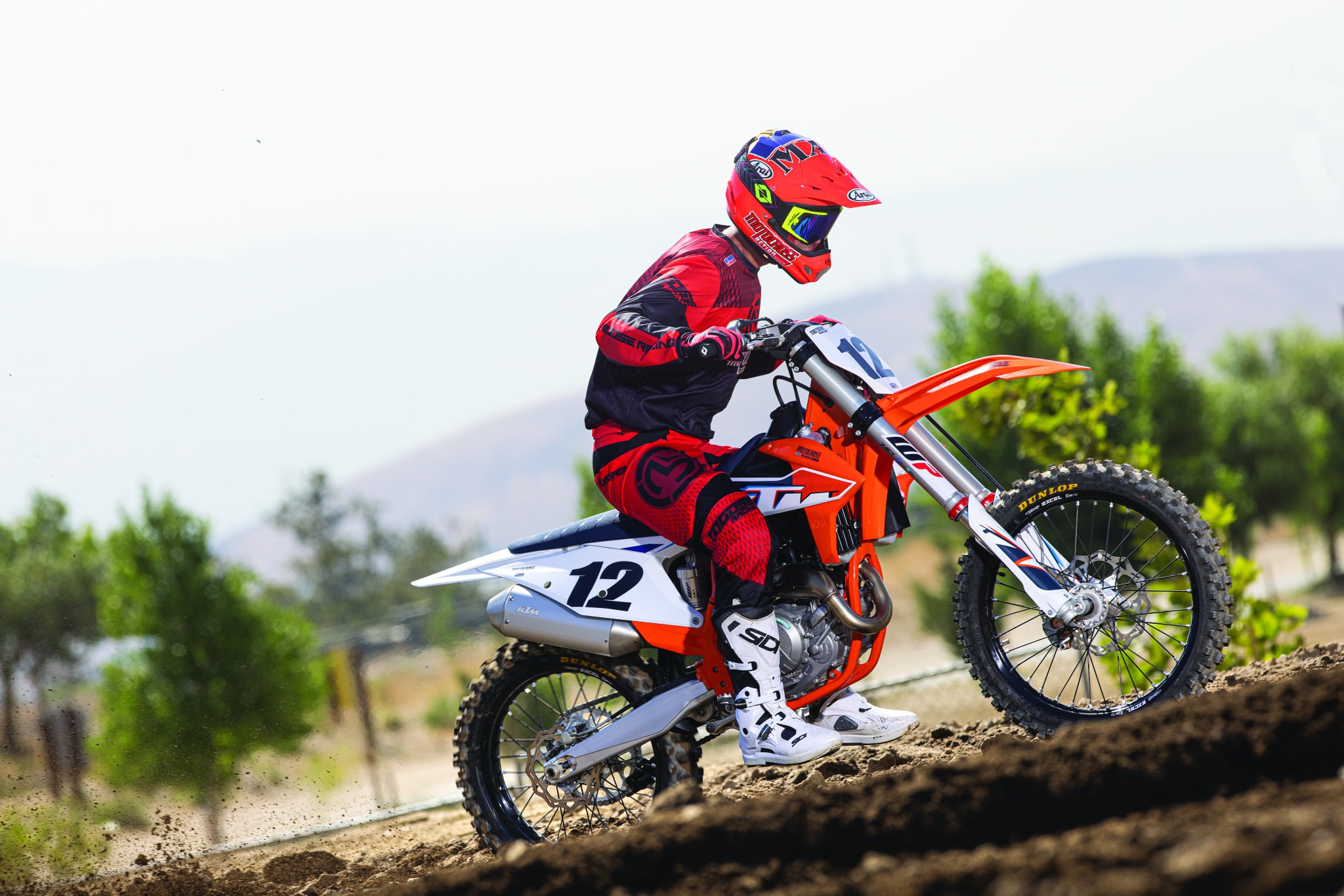 THE GEAR: Jersey: Moose Racing Qualifier, Pants: Moose Racing Qualifier, Helmet: Arai VX-Pro4, Goggles: Viral Brand Works Series, Boots: Sidi Atojo.
THE GEAR: Jersey: Moose Racing Qualifier, Pants: Moose Racing Qualifier, Helmet: Arai VX-Pro4, Goggles: Viral Brand Works Series, Boots: Sidi Atojo.
Q: FIRST AND FOREMOST, IS THE 2022 KTM 450SXF BETTER THAN THE 2021 450SXF?
A: Yes, but barely for 2022, there are only four changes on the KTM 450SXF, and three of those are cosmetic.
(1) BNG. The new KTM radiator graphics are a “bold new” look, and at first, every MXA test rider thought they looked a little cartoonish, but they grew on us.
(2) Orange frame. Not to reveal KTM’s less-than-cryptic code book, but when an orange frame appears on a KTM production bike, that is a dead giveaway that next year’s model will be all-new. The 2023 KTM 450SXF will have a new frame, swingarm, engine and plastic.
(3) Blue seat cover. It was black in 2021, and it is blue in 2022.
(4) Air/oil separator. Air/Oil Separators (AOS) separate excess air pressure from engine oil. If you’ve ever noticed an oil mist on your engine, that is blow-by from trapped internal air pressure. An AOS reduces unsightly oil blow-by by using centrifugal force to route the air out through a vent tube in the top of the valve cover while sending the oil back to the crankcase, sans the air. It should be noted that only the 2022 KTM 450SXF got the air/oil separator, not the KTM 250SXF or KTM 350SXF.
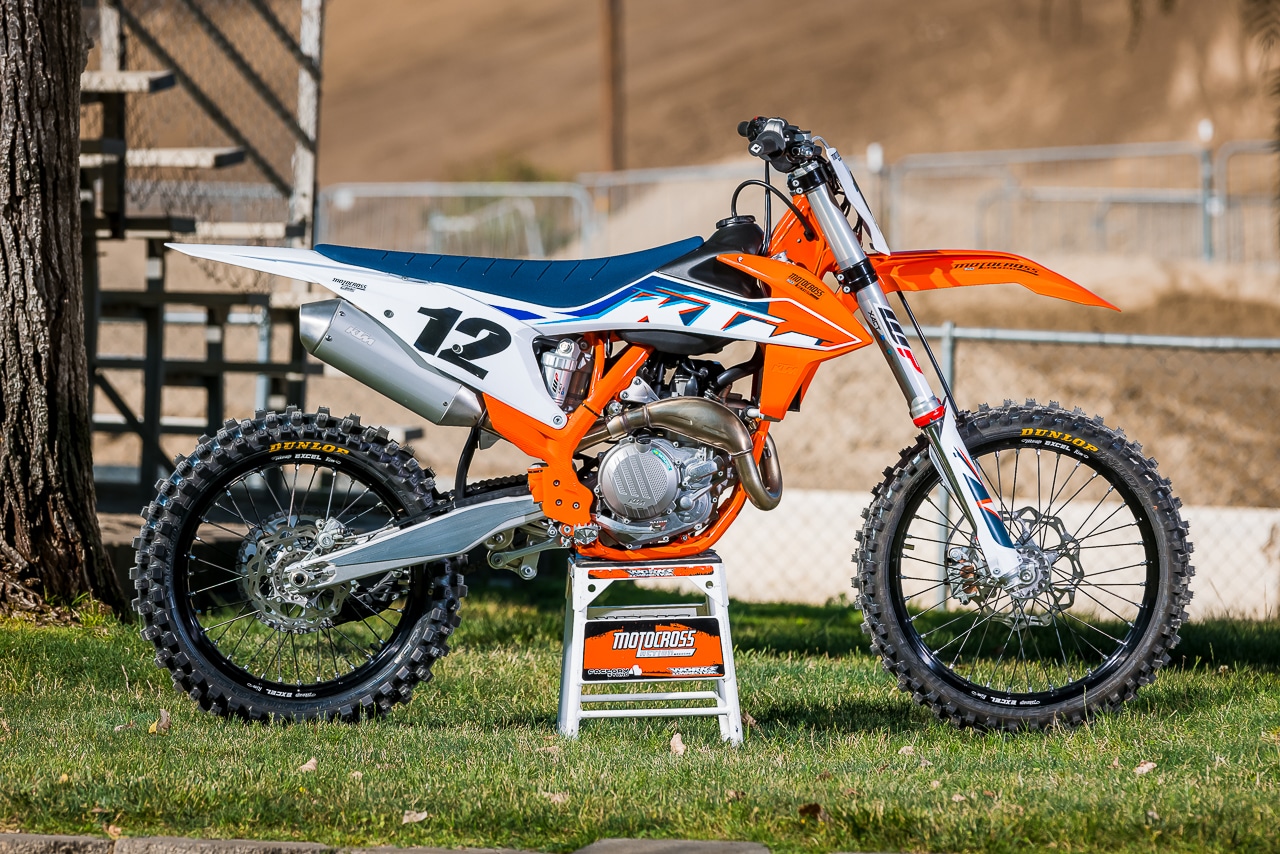
Q: HOW DOES THE 2022 KTM 450SXF HANDLE?
A: The KTM chassis is one of the best all-around-handling frames on the track (matched by its white or red brethren). Make no mistake about it, there are brands that turn sharper, but they shake, push or get loose on corner exit. There are brands that feel lighter in the air, but that’s an illusion, because they aren’t lighter in reality. The KTM 450SXF is light, and you can feel the lack of excess heft on the track. The chassis dimensions allow you to have your cake and eat it, too. It can turn with the best in the class and still be stable at speed. Additionally, thanks to the latest generation of WP XACT air forks, the bike feels more connected to the ground. It is more accurate at turn-in and almost flawless at any speed.
The 2022 KTM 450SXF chassis has a naturally resilient feel in motion that is a byproduct of the inherent liveliness of chromoly steel. You may think that chromoly steel frames are old-fashioned and out of sync with modern technology, but you are wrong. Steel produces a more forgiving frame because its elementary characteristic is to bow to harsh forces rather than fight them. Aluminum’s large-grain structure results in less yield strength, which is how much a material can be deformed before it reaches its limit. Chromoly’s yield and tensile strength are vastly superior to that of aluminum. That doesn’t mean that aluminum can’t be made into a good motocross frame, but it means that aluminum has to be used structurally—not in small, light tubes, but in forgings, castings and extrusions. If you duplicated a KTM frame out of aluminum tubing, it would break almost immediately. If you duplicated an aluminum Honda Delta-Box frame out of chromoly, it would weigh a ton.
Q: HOW DOES THE 2022 KTM 450SXF RUN?
A: Depending on how much power you want, where you want it and how much you want it to rev, there is an engine in the “Big 7” that is perfect for you. But, for the MXA wrecking crew’s taste buds, the 2022 KTM 450SXF power delivery is next to perfect. The KTM 450SXF delivers a metered, controlled, crescendo-style of power. If you think that 450s are too powerful for mortal men, the 2022 450SXF will give you a nice, pleasant, roll-on style of power that is user-friendly—if you stop turning the throttle in the midrange. If you like a strong midrange powerband that lets you blend the tractable low-end with a surging escalation as the rpm climbs, the 2022 KTM 450SXF gives you all the thrust you need as the rpm climbs. . But, if you want to go fast—really fast—all you have to do is hurry through the low-end, grip tighter in the midrange, and hang on for a surge of power that doesn’t hit as much as it cascades in ever-increasing quantities. It almost dares you to keep the throttle wide open—and rewards those who do.
What’s great about the KTM 450SXF powerband is that you can use as much or as little as you need. It doesn’t scare you like a horror movie; instead, it lulls you into going faster than you would go on a fire-breathing dragon of a 450. Great engine—and not just for Pros but for every skill level.
Helping make the KTM suit a wide variety of skill levels is KTM’s electronic suite (Map 1, Map 2, Traction Control and Launch Control). Map 1 is the Mellow map. It delivers an easy-to-ride power delivery. It makes the engine less abrupt and more manageable. Map 2 is the Aggressive map. It is considerably crisper, more responsive and pulls harder. MXA test riders prefer Map 2 on a day-to-day basis, but if the track is hard-packed, slippery, wet or extremely technical, they will switch to Map 1. Another option is to combine Map 1 or Map 2 with traction control (TC). We don’t just use traction control on rock-hard dirt; instead, we engage it to maximize those sketchy moments when the rear end steps out or skitters across the braking bumps. TC doesn’t kill the horsepower, unless the ECU reads runaway revs.
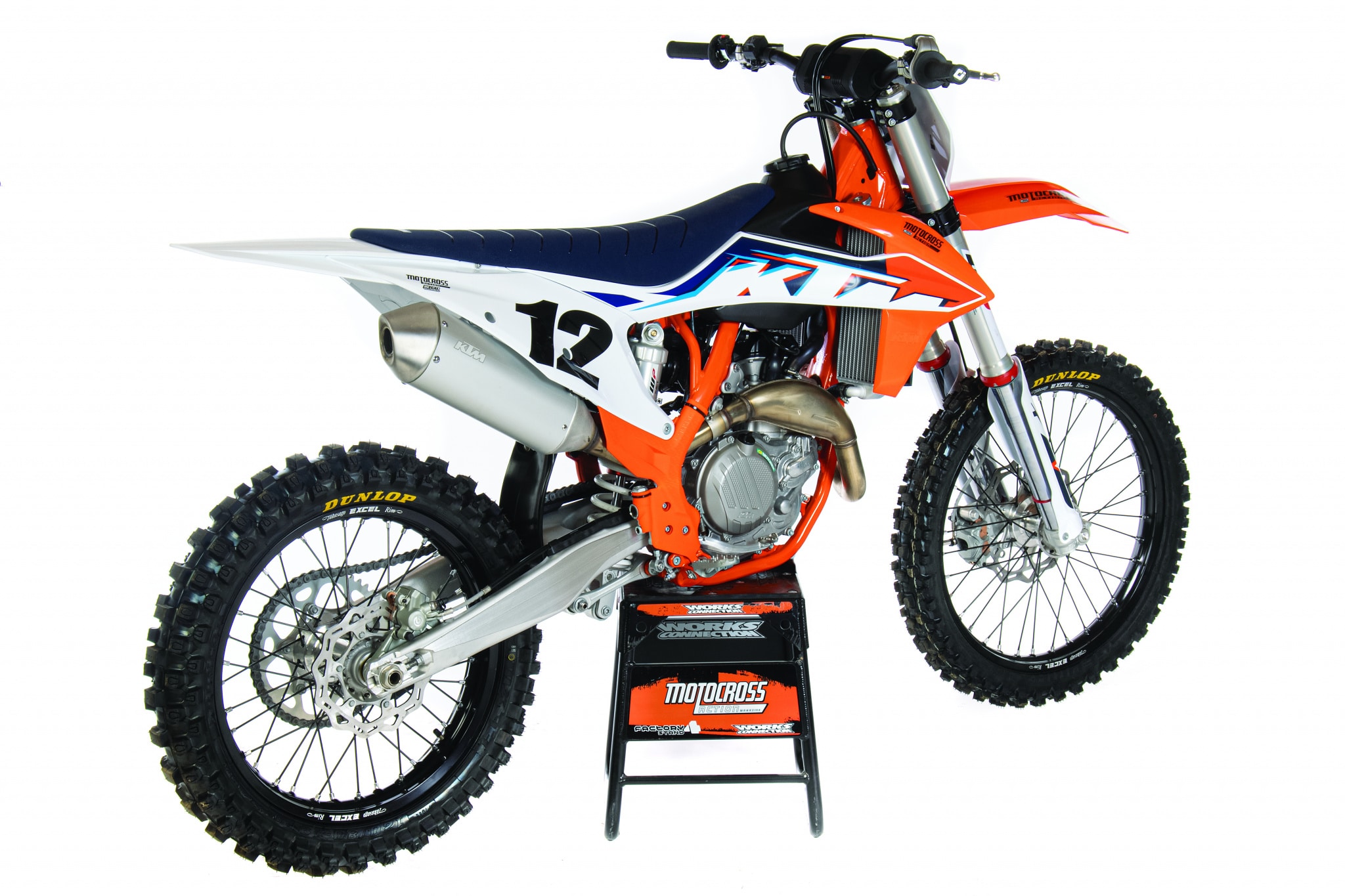 Whereas the GasGas MC 450F has softer suspension and the Husqvarna FC450 has lower suspension, the KTM 450SXF rides higher in its stroke and feels more capable at higher speeds.
Whereas the GasGas MC 450F has softer suspension and the Husqvarna FC450 has lower suspension, the KTM 450SXF rides higher in its stroke and feels more capable at higher speeds.
Q: IS THE VENTED AIRBOX COVER REALLY WORTH THE TROUBLE?
A: Yes. Most MXA test riders run the vented cover all the time, but if they find themselves on a super-slick track or in a sudden downpour, they don’t waste time with the non-vented OEM cover. Instead, they tape the vent holes over with duct tape. The vented airbox cover produces a noticeable increase in throttle response and an increased rate of acceleration in the midrange. It is also worth 1 horsepower at high rpm.
Q: WHAT SHOULD YOU DO TO GET THE MOST OUT OF YOUR 2022 KTM 450SXF?
A: Every bike has its own personal peccadilloes. Here are the things we watch on the 2022 KTM 450SXF.
ECU. To maximize performance, you should initialize the ECU before riding the bike, especially if the temperature, altitude or weather conditions have changed since the last time you rode. All you have to do is start the bike and let it idle for three to four minutes. Do not touch the throttle during initialization.
Brake rotor. Before the first time you ride your new 450SXF, clean the front and rear brake rotors with brake cleaner (and wipe with a clean, dry rag).
Clutch rubbers. Replace the clutch rubber bumpers every six months. Rekluse makes aftermarket clutch rubbers that last longer than stock.
Chain adjustment. You need 55mm of chain free-play when measured from the back edge of the chain slider. If you are lucky, three of your fingers might be 55mm wide.
Bleed screws. KTM needs to change the fork’s bleed screws from Torx back to Phillips-head screws.
Kill button. The bikes are shipped to America with the kill button mounted inboard of the map switch and clutch perch; we moved the kill button next to the left grip.
Finding neutral. Getting the transmission into neutral on the starting line is hard. Sometimes it helps to rev the engine really high and then snick the shift lever before the rpm falls off. If this doesn’t work, use your hand.
Wiring. The starter-button wire pulls out of the white junction box behind the front number plate occasionally. When it does, nothing happens when you press the starter button. If you can stick the wire back into the proper plug, do it and then wrap it with electrical tape.
Idiot light. The LED light on the FI idiot light that is used for maintenance codes and Launch Control engagement falls out of its plug-in rubber holder all the time.
Preload ring. The plastic preload ring needs to be beefed up, because if you use a hammer and screwdriver to move it, the ring gets notched out. We take a long flat-bladed screwdriver and use the frame as a fulcrum to move the collar by prying on the preload ring. If you have the money to buy the Xtrig preload adjuster, do it. It is awesome!
Tie-down warning. Be very careful when hooking tie-downs onto your handlebars so that they don’t crimp the metal tube coming out of the front-brake master cylinder. Always use soft straps and tuck them under the brake and clutch hoses.
Fork compression adjuster. The thin and short compression clickers hurt your fingers after a few clicks. WP needs to make the wing-nut-like clickers more finger-friendly by making them longer for better leverage.
Loose bolts. All bikes have bolts that come loose under the rigors of motocross. On the 2022 KTM 450SXF, we pay attention to the head-stay bolts, lower subframe bolts, shift-lever bolts, sprocket bolts and front motor-mount bolt.
Bar-mount twist. The bar mounts twist in even the smallest crash. In 2016, KTM had a one-piece bar mount under the handlebars. Then, in 2017, they changed to a one-piece bar mount on top of the handlebars. Neither setup stopped the bars from twisting. MXA runs the 2016 one-piece bottom bar mount with the 2022 one-piece top bar mount to stop the twist.
Bar-mount tightening. Be forewarned that you can’t tighten the 17mm nuts under the bar mounts without taking the handlebars off and holding the bar-mount bolt with a #45 Torx wrench.
Head-stay bolts. We torque the #45 Torx head-stay bolts to 25 N/m (and add a small dab of Loctite 243 to each bolt). Sadly, one right-side head-stay bolt cannot be tightened without removing the pipe.
Motor-mount bolts. Always check the front mount bolt on the engine; odds are it is loose.
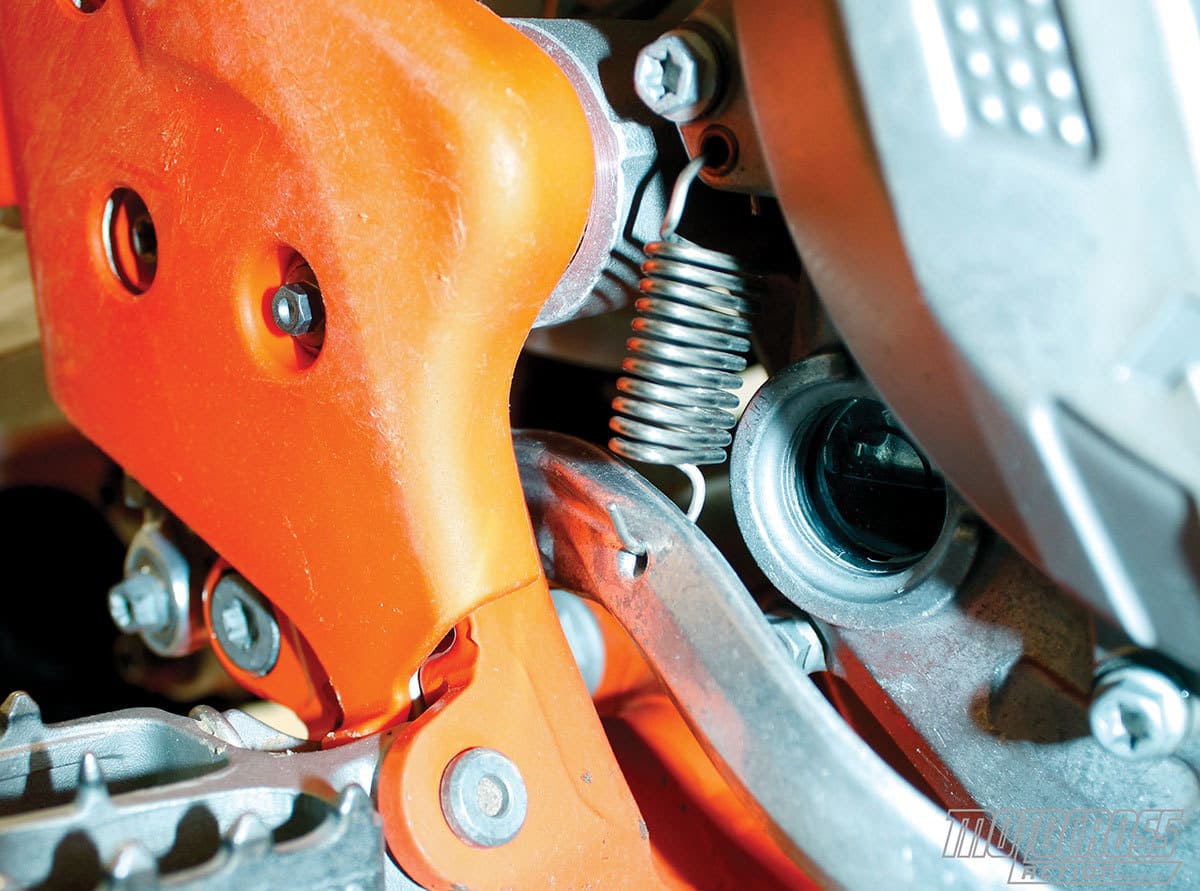 If your rear brake pedal spring looks like this, it’s on backwards. Flip it over.
If your rear brake pedal spring looks like this, it’s on backwards. Flip it over.
Rear-brake pedal spring. We turn the rear-brake pedal spring over so that the bottom tang curves towards the engine. This keeps your boot from unhooking the spring, which happens when the spring’s tang is sticking outwards.
Inline fuel filter. Change your inline fuel filter after break-in. There is often plastic flashing inside new gas tanks.
Swingarm pivot bolt. At regular intervals, remove the plastic frame guards and torque the swingarm pivot bolt to 100 N/m.
Adjust throttle play. There are two adjusters on the throttle housing that can be turned to take free-play out of the throttle.
Triple-clamp bolts. The stock-recommended torque on the triple clamp’s pinch bolts is 17 N/m (top) and 12 N/m (bottom). MXA test riders go to 20 N/m (top) and 14 N/m (bottom).
Steering stem. Make sure that your steering stem is properly tightened, especially after break-in. The correct method is to loosen the four top triple-clamp pinch bolts and the 10mm bolt on the back of the triple clamps before tightening the 17mm bolt at the top of the triple clamps a little at a time. Most MXA test riders check for their favorite steering-stem tightness by flopping the forks back and forth until the resistance feels right.
Spares. MXA carries a spare shock linkage nut, inline fuel filters, nylon airbox grommets, inline fuel filter rubber O-rings and rear-brake pedal springs with us to every race.
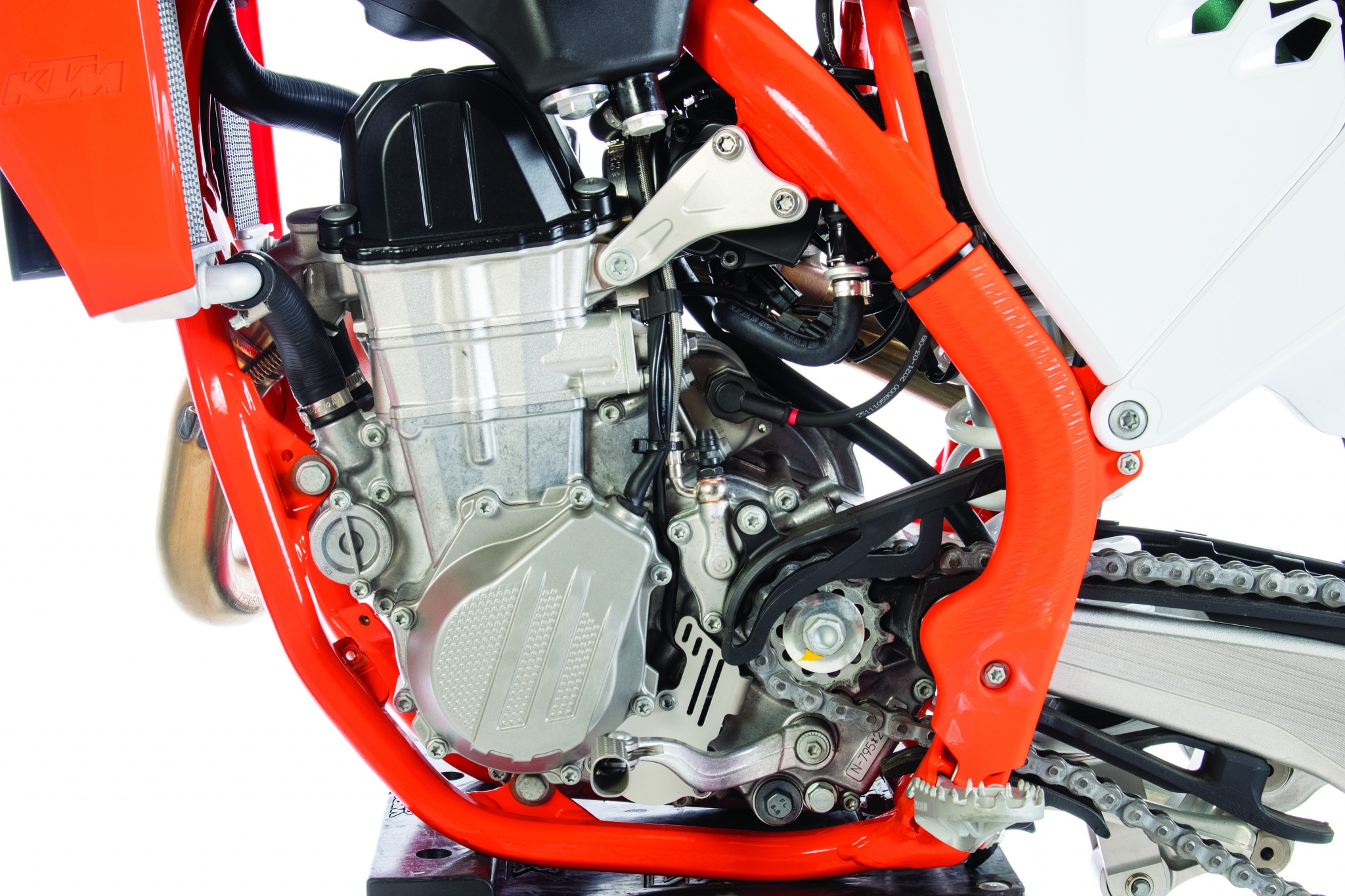 It is the powerband characteristics that set the KTM 450SXF apart from the FC450 and MC 450F engines. But, the engine is not where the differences emanate.
It is the powerband characteristics that set the KTM 450SXF apart from the FC450 and MC 450F engines. But, the engine is not where the differences emanate.
Q: WHAT DID WE HATE?
A: The hate list:
(1) Gas cap. It sticks—not every time at the track, but too often at the gas station.
(2) Neutral. Finding neutral is a trade-off. KTM has down-sized the neutral detent to make it difficult for the transmission to pop into neutral by accident. The price we pay for that safety factor is that neutral is hard to find.
(3) Bike stand. When the bike is sitting on a bike stand, the front wheel is on the ground. This is a hassle when checking the spokes or working on the front end. At the track, we stick a crescent wrench under the front of the frame to get the wheels off the ground. MXA races different bikes every week, so we don’t want tilted bike stands or stands with bumps on them.
(4) Teeth. The rear sprocket bolts come loose with alarming regularity. It only takes three minutes to tighten the sprocket bolts with a 13mm wrench.
(5) Nipples. Check the spokes every race morning, starting at the spokes next to the rim lock, which are the ones that come loose first.
Q: WHAT DID WE LIKE?
A: The like list:
(1) Weight. At 223 pounds, the 2022 KTM 450SXF is 10 pounds lighter than the 2022 CRF450, 11 pounds lighter than the 2022 KX450, 15 pounds lighter than the YZ450F and 18 pounds lighter than the RM-Z450. You may think that weight doesn’t matter, but your bike’s rims, spokes, frame, shock spring, brakes and acceleration are weight-sensitive.
(2) Throttle cam. Your KTM sat on the showroom floor with the stock, long-throw, gray throttle cam installed. Take it out and put on the quick-turn black throttle cam that came as an option.
(3) Twin Air filter. If you’ve never installed an air filter into a KTM or Husqvarna, you will be amazed at how foolproof it is compared to the normal gymnastics of other air-filter/cage/airbox designs.
(4) Pankl transmission. No other motocross brand offers a transmission built by a Formula 1 gearbox supplier. Pankl’s metallurgy is a step above what other brands offer.
(5) Bushings. The traditional top-end rod bearing has been replaced by a bronze bushing, while the crankshaft’s big end features a plain bushing with two force-fitted bearing shells for a 100-hour service time.
(6) No-tools rebound adjuster. Thanks to the extra space created by removing the bottoming cone in 2021, WP eliminated the need to get down on your hands and knees to adjust the rebound damping with a screwdriver. Now, a racer can adjust the fork’s rebound damping by turning the clicker by hand.
(7) Chain guide. We put a TM Designworks chain guide on almost every Japanese 450, but not on a KTM.
(8) Wheel spacers. KTM has awesome wheel spacers. Unlike on a lot of motocross bikes, KTM’s wheel spacers run on bearings, which means that the front and rear wheels can accept different axle sizes just by changing the wheel spacers. This makes older KTM wheels compatible as spare wheels on new-model KTMs (and vice versa).
(9) Hour meter. Kudos to KTM for putting an hour meter on its bikes as standard equipment.
(10) ODI grips. We like the ODI lock-on grips, because if we crash and rip the grip, we can put a new ODI grip on without having to wait for the glue to dry. If you want cushier grips, go with the glue-on ODI grips.
(11) Quick-release fuel lines. The KTM comes with fuel lines that can be disconnected without breaking the steel band that holds other brands’ fuel lines on. And, there is an inline fuel filter that can be removed and replaced in under three minutes.
(12) Plastic frame guards. They keep your boots from rubbing the paint off the side of the frame.
Q: WHAT DO WE REALLY THINK?
A: The 2022 KTM 450SXF is a lot more expensive than a YZ450F, CRF450, RM-Z450 or KX450. That extra moolah buys you the broadest powerband, longest-lasting clutch, most powerful brakes, best shifting, lightest weight, most accurate handling, easiest-to-use air filter and a Formula 1 transmission. Is it worth it to you?
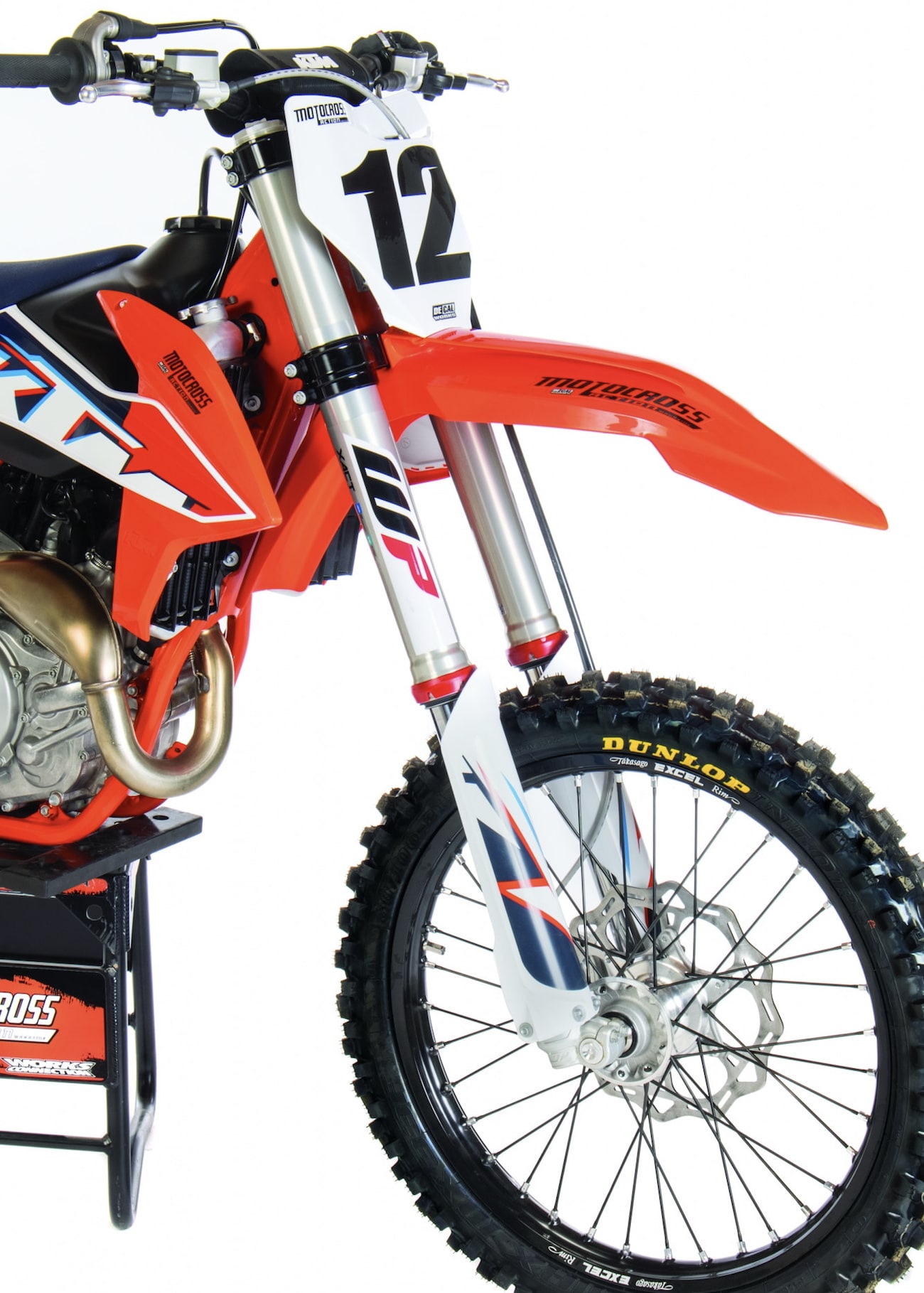 The WP XACT Air forks work very well under all conditions, but only if you take the time to learn how they work.
The WP XACT Air forks work very well under all conditions, but only if you take the time to learn how they work.
MXA’S 2022 KTM 450SXF SETUP SPECS
This is how we set up our 2022 KTM 450SXF suspension for racing. We offer it as a guide to help you find your own sweet spot.
WP AER FORK SETTINGS
There is a learning curve to getting the most out of the 2022 XACT air forks. The KTM WP XACT air fork has one Schrader valve to put air in or take air out. The right fork leg is strictly damping, and the left leg is air only. KTM has a sticker on the air leg to guide you to its recommended air pressure. It is a very good starting point, but it’s just a suggestion, not an ironclad law. MXA has test riders who run as much as 160 psi and test riders who run as low as 135 psi. The 2022 forks have the potential to be great. For hardcore racing, we recommend this fork setup for an average rider on the 2022 KTM 450SXF (stock specs are in parentheses):
Spring rate: 154 psi (Pro), 150 psi (Intermediates), 145 psi (fast Novices), 140 psi (Vets and Novices)
Compression: 20 clicks out (12 clicks out)
Rebound: 15 clicks out (18 clicks out)
Fork-leg height: Third line
Notes: Test riders started with the compression at 12 clicks out and the rebound on 18 clicks out, but went out on the compression and in on the rebound. The 2022 KTM 450SXF comes with rubber rings on each leg to allow the rider to see how much travel he is getting at a given pressure, but the orange rings wear out and slide down by themselves after a couple of hours. We got our best feel when the rubber ring was within 1-1/2 inches of bottoming. With that pressure, we could use the compression damping to fine-tune the travel.
WP SHOCK SETTINGS
Most MXA test riders liked the overall feel of the WP rear shock, especially after KTM lowered the shock spring rate in 2017 from 48 N/mm to 45 N/mm. WP did make some technical changes to the WP XACT shock, but they are mostly focused on a more responsive feel. We run the low-speed compression on 15 clicks out, the high-speed compression 1-1/4 turns out, the rebound on 10 clicks out and set the sag at 105mm. For hardcore racing, we recommend this shock setup for the 2022 KTM 450SXF (stock specs are in parentheses):
Spring rate: 45 N/mm
Race sag: 105mm
Hi-compression: 1-1/4 turns out (1-1/2 turns out stock)
Lo-compression: 15 clicks out
Rebound: 10 clicks out (15 clicks out stock)
Notes: Static sag, measured without the rider on the bike, should be between 30mm and 40mm. To measure static sag, first set your race sag to 105mm. Next, take the bike off the stand and have someone hold it vertically while you measure how much the rear suspension sags without a rider on it. If your static sag is more than 40mm, your spring may be too stiff for your weight. In this case, the spring is not compressed enough to allow the suspension to extend far enough on its own. A spring that’s too firm does not allow the rear tire to hook up under acceleration and transmits more bump energy into the rider.
If the static sag is less than 30mm in the rear, the spring may be too soft for your weight. In this case, the spring requires so much preload to achieve the proper race sag that it makes the rear suspension prone to topping out under hard braking into corners and feel loose and wallowy under acceleration.


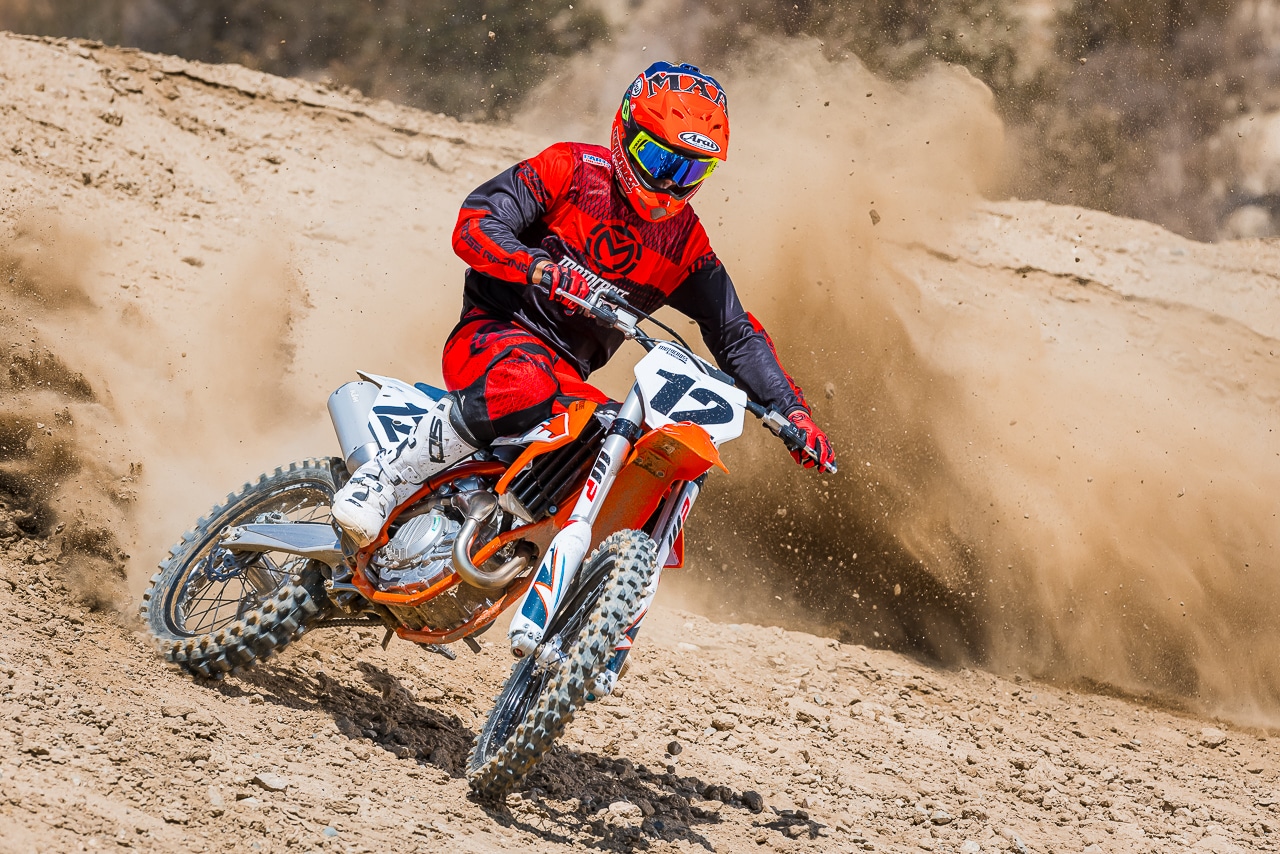

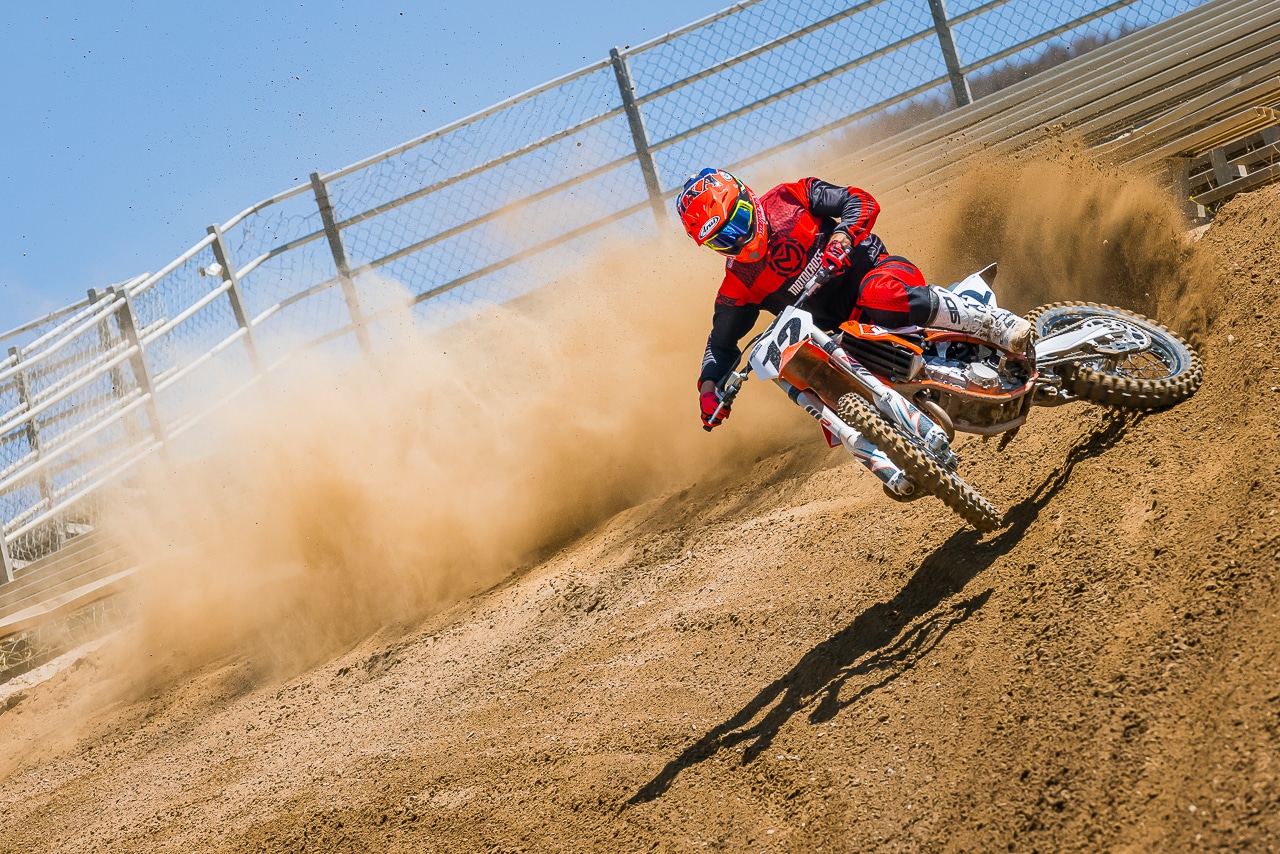



Comments are closed.